
| Llwydcoed | |
| The history of the modern village of Llwydcoed begins with the building of the Aberdare Ironworks. In common with the other areas of the Cynon Valley where early ironworks were founded, notably Hirwaun and Abernant, industry acted as the catalyst for the settlement and development of the area. Prior to the construction of the ironworks Llwydcoed had been an agricultural community of scattered farms. | |
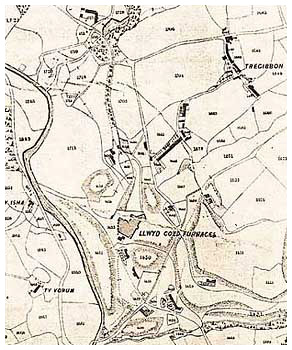 |
Initial development of the village was based around the Tregibbon area, where in 1801 workers' housing was built by Thomas ap Shencin ap Gibbon of Fforchaman Farm. Other early housing was built at Miner's Row, Founder's Row and Scales Houses. The names of these streets betray their early origins; the Scale family were among the founders of the works and remained partners until 1846. In the second half of the Nineteenth Century a new period of growth was instigated by the development of the coal industry in the area. Matthew Wayne Esq. of the Gadlys Ironworks opened the Dyllas Colliery in 1840 and in 1849 Ysguborwen Colliery was sank by Samuel Thomas and Thomas Joseph. Among the houses built in this period were those at Moriah Place, Horeb Terrace and Grey's Place. Exhibition Row was built in 1851 and was named Exhibition Row in honour of the Great Exhibition held at Crystal Palace that year. Left: Llwydcoed section of the Aberdare Parish Tithe Map (1847). The map illustrates the pattern of early settlement in the village. Tregibbon to the North, with Miner's Row and Kingsbury Place to the South, just above the furnaces. |
| Eight public houses were open in Llwydcoed at this time. They were The Earl Grey, Fox and Hounds, Red Cow, Corner House, The Mason's, Miner's Arms, the Dynevor Arms and the Croes Bychan. At that time stop tap was midnight and a local essayist recounts the boisterous nature of the revelries.
"It is said that more beer was lost (wasted) when the furnaces, coal mines and iron-ore undertakings were being worked, especially at the start of the month, and on pay Saturday Night, than is being drunk now." (Unknown Author. 'A Glance at the History of Llwydcoed' Translated by D Williams and D L Davies.) Right: Rees Hopkin Rhys JP |
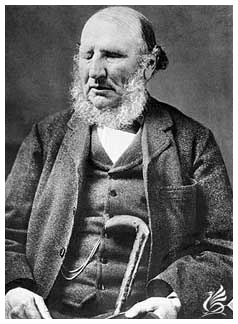 |
Rees Hopkin Rhys - was one of the most influential men in the development of local government in Aberdare and the surrounding area. Born in Llwydcoed in 1819, where he lived most his life at Plasnewydd, he became a respected mineral agent at an early age, but was blinded at the age of 28 whilst conducting experiments with gun cotton. During the Twentieth Century the industrial base of Llwydcoed began to change. The Ironworks had closed some time earlier in 1875. In 1919 Ysguborwen Colliery closed and the Dyllas Colliery finally closed during the 1920's. However, in 1906 the Tanybryn Brickworks opened on the site of the Aberdare Ironworks and the brickworks remained open under a number of different owners until December 1981. In the late 1940's the coal reserves of the area were exploited again when the Bryn Pica opencast site was opened. |
|
| Llwydcoed Ironworks | |
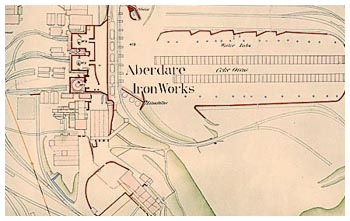 |
The Aberdare Ironworks at Llwydcoed was founded in 1800, when a partnership consisting of John Thompson, John Hodgett, George Scale and John Scale took out a lease for 702 acres of land on the Llwydcoed Forest Estate. The lease was to run for 70 years at the cost of £1,000 per annum. Two furnaces were built on the site which were waterwheel blown, the waterwheel being fed by a leat that was connected to the River Cynon a mile upstream, and the works opened in 1801. The Aberdare Iron Company appears to have started successfully. In 1805 3,586 tons of iron were produced at the works and the company was able to successfully weather the depression in the iron trade of 1813/14 unlike the other Cynon Valley Ironworks. |
Above: Aberdare Ironworks as depicted on the 1st Edition Ordnance Survey Map of 1868. Clearly seen on the map are the three blast furnaces and the line of coke ovens needed to produce fuel for the works. |
In 1812 a tramroad was built to connect the Aberdare Ironworks with the Canal Head of the newly constructed Aberdare Canal at Cwmbach. The tramroad crossed the River Cynon twice during its route, once at Gelli Isaf just below the ironworks and again at the Robertstown Tramroad Bridge. In 1819 the Aberdare Iron Company expanded considerably when it bought the nearby Abernant Ironworks. |
By 1823 three furnaces were in production at each site and the firm produced 12,571 tons of iron in 1830. Right: The Aberdare Ironworks in the 1880's shortly after it's closure in 1875. The site buildings are still in a good condition at this date and the three blast furnaces can be seen in the centre of the photograph. |
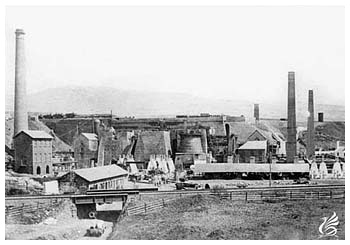 |
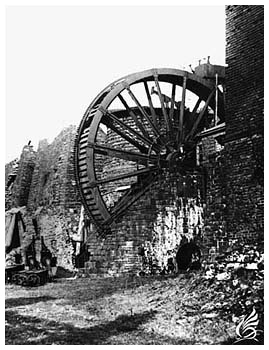 |
Up to this date the Aberdare Iron Company had not produced wrought iron at their ironworks but this changed following the takeover by the Fothergills, who built puddling furnaces at Abernant Ironworks and modernised both the works. Output appears to have continued to increase and by the mid 1860's the company had become one of the major suppliers in the wrought iron rail trade. In 1872 the company was supplying rails worldwide, including to New Orleans, New York and Montreal. This success, however, disguised some serious problems at the Aberdare Iron Company. In 1875 following the end of the demand for wrought iron rails the company collapsed suddenly. Left: The Aberdare Ironworks made use of a waterwheel to provide blast from their opening in 1801. By 1869 two waterwheels of 40 feet in diameter and 5 feet wide were in use at the site |